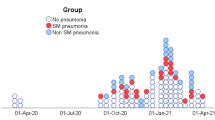Abstract
Ventilator-acquired pneumonia and hospital community-acquired pneumonia are frequently caused by Gram-negative and -positive bacteria. We noted that pneumonia patients with co-infection of Pseudomonas aeruginosa and Stenotrophomonas maltophilia had a poor clinical outcome. To verify this, we retrospectively reviewed pneumonia cases at Hebei General Hospital from 2010 to 2015. These cases were grouped into four categories: (1) co-infection with P. aeruginosa and S. maltophilia, (2) infection with P. aeruginosa, (3) infection with S. maltophilia and (4) infection with none of the known pneumonia-causing pathogens. The numbers of cases in each group were 50, 40, 41 and 33, with mortality rates of 64.0%, 12.5%, 14.6% and 6.1%, respectively. The analysed results indicated that a co-infection of P. aeruginosa and S. maltophilia had a synergic impact on the mortality of pneumonia patients. Therefore, future research is needed to develop treatment strategies for the co-infected patients to reduce the rate of mortality.

Similar content being viewed by others
References
Cook D (2000) Ventilator associated pneumonia: perspectives on the burden of illness. Intensive Care Med 26(Suppl 1):S31–S37
Lim WS, van der Eerden MM, Laing R, Boersma WG, Karalus N, Town GI, Lewis SA, Macfarlane JT (2003) Defining community acquired pneumonia severity on presentation to hospital: an international derivation and validation study. Thorax 58(5):377–382
Behnia M, Logan SC, Fallen L, Catalano P (2014) Nosocomial and ventilator-associated pneumonia in a community hospital intensive care unit: a retrospective review and analysis. BMC Res Notes 7:232
Jones RN (2010) Microbial etiologies of hospital-acquired bacterial pneumonia and ventilator-associated bacterial pneumonia. Clin Infect Dis 51(Suppl 1):S81–S87
Chi SY, Kim TO, Park CW, Yu JY, Lee B, Lee HS, Kim YI, Lim SC, Kwon YS (2012) Bacterial pathogens of ventilator associated pneumonia in a tertiary referral hospital. Tuberc Respir Dis (Seoul) 73(1):32–37
Streeter K, Katouli M (2016) Pseudomonas aeruginosa: a review of their pathogenesis and prevalence in clinical settings and the environment. Infect Epidemiol Med 2:25–32
Brooke JS (2012) Stenotrophomonas maltophilia: an emerging global opportunistic pathogen. Clin Microbiol Rev 25(1):2–41
Loens K, Van Heirstraeten L, Malhotra-Kumar S, Goossens H, Ieven M (2009) Optimal sampling sites and methods for detection of pathogens possibly causing community-acquired lower respiratory tract infections. J Clin Microbiol 47(1):21–31
Zaiontz C (2015) Real Statistics Using Excel. Home page at: http://www.real-statistics.com. Accessed 24 Jul 2016
Slinker BK (1998) The statistics of synergism. J Mol Cell Cardiol 30(4):723–731
Hathroubi S, Mekni MA, Domenico P, Nguyen D, Jacques M (2016) Biofilms: microbial shelters against antibiotics. Microb Drug Resist 23(2):147–156
Varposhti M, Entezari F, Feizabadi MM (2014) Synergistic interactions in mixed-species biofilms of pathogenic bacteria from the respiratory tract. Rev Soc Bras Med Trop 47(5):649–652
Ryan RP, Fouhy Y, Garcia BF, Watt SA, Niehaus K, Yang L, Tolker-Nielsen T, Dow JM (2008) Interspecies signalling via the Stenotrophomonas maltophilia diffusible signal factor influences biofilm formation and polymyxin tolerance in Pseudomonas aeruginosa. Mol Microbiol 68(1):75–86
Gilbert P, Allison DG, McBain AJ (2002) Biofilms in vitro and in vivo: do singular mechanisms imply cross-resistance? J Appl Microbiol 92(Suppl):98S–110S
Pompilio A, Crocetta V, De Nicola S, Verginelli F, Fiscarelli E, Di Bonaventura G (2015) Cooperative pathogenicity in cystic fibrosis: Stenotrophomonas maltophilia modulates Pseudomonas aeruginosa virulence in mixed biofilm. Front Microbiol 6:951
Hoffmann N, Rasmussen TB, Jensen PØ, Stub C, Hentzer M, Molin S, Ciofu O, Givskov M, Johansen HK, Høiby N (2005) Novel mouse model of chronic Pseudomonas aeruginosa lung infection mimicking cystic fibrosis. Infect Immun 73(4):2504–2514
D‘Argenio DA, Wu M, Hoffman LR, Kulasekara HD, Déziel E, Smith EE, Nguyen H, Ernst RK, Larson Freeman TJ, Spencer DH, Brittnacher M, Hayden HS, Selgrade S, Klausen M, Goodlett DR, Burns JL, Ramsey BW, Miller SI (2007) Growth phenotypes of Pseudomonas aeruginosa lasR mutants adapted to the airways of cystic fibrosis patients. Mol Microbiol 64(2):512–533
Acknowledgements
The authors are grateful to the doctors and nurses of Hebei General Hospital for their detailed documentation for every case history, making this retrospective review and study possible.
Author information
Authors and Affiliations
Corresponding author
Ethics declarations
Funding information
No external funding has been sought. All authors are employed by the relevant institutes. However, the institutional employers have no influence on the data collection, analysis and conclusions drawn in this paper.
Conflict of interest
The authors have declared that no competing interests exist.
Ethical statement
This paper is based on the data from a retrospective statistical analysis of clinical records. No clinical tests were conducted and no ethical issue approval was required. However, the institutional research and ethics guidelines were observed in this retrospective study to guard the patients’ privacy and confidentiality.
Data availability
The dataset used for analyses during the current study is available from the corresponding author upon request.
Electronic supplementary material
Below is the link to the electronic supplementary material.
ESM 1
(DOC 194 kb).
Rights and permissions
About this article
Cite this article
Yin, C., Yang, W., Meng, J. et al. Co-infection of Pseudomonas aeruginosa and Stenotrophomonas maltophilia in hospitalised pneumonia patients has a synergic and significant impact on clinical outcomes. Eur J Clin Microbiol Infect Dis 36, 2231–2235 (2017). https://doi.org/10.1007/s10096-017-3050-4
Received:
Accepted:
Published:
Issue Date:
DOI: https://doi.org/10.1007/s10096-017-3050-4




